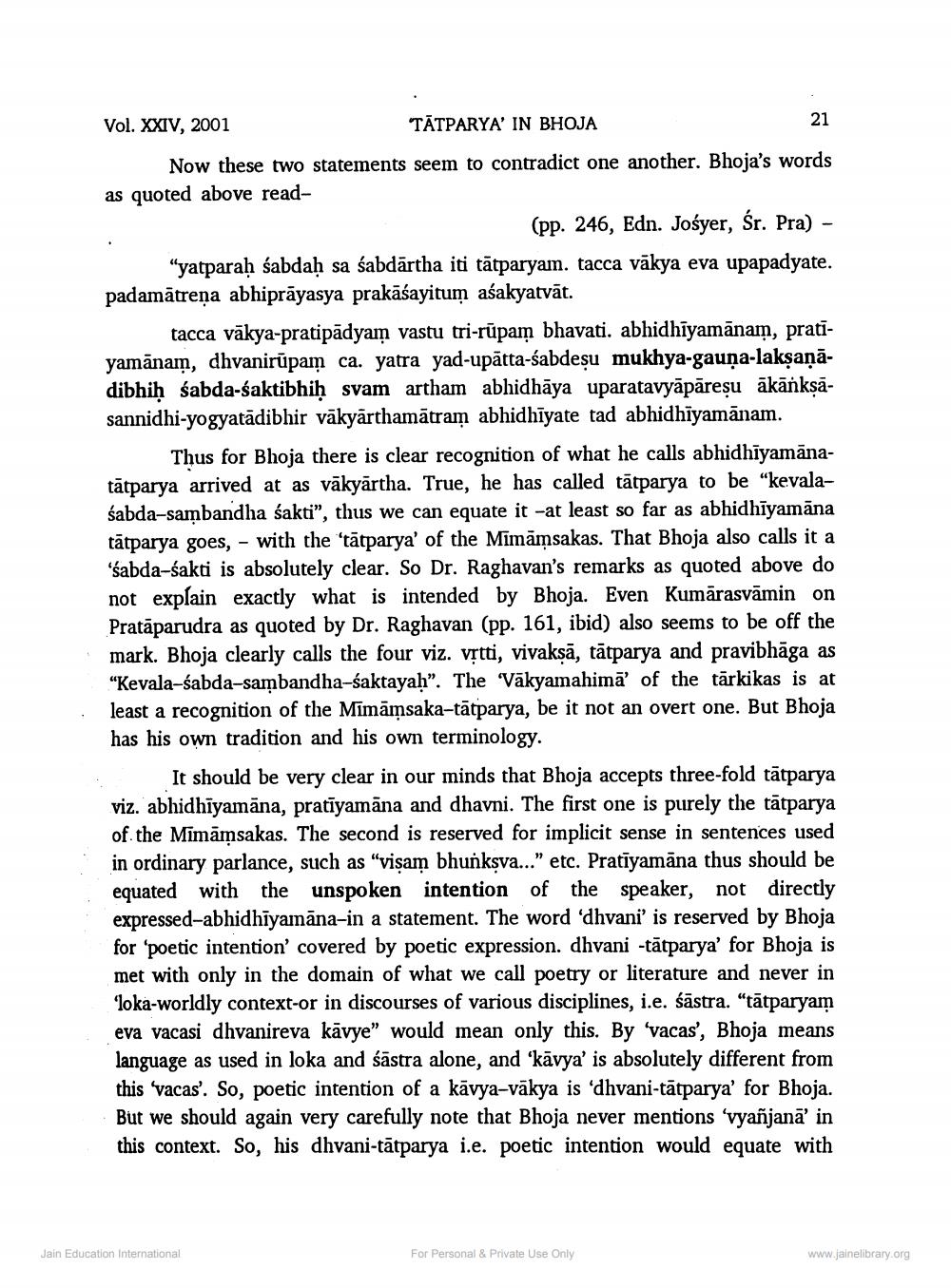________________
Vol. XXIV, 2001
TĀTPARYA' IN BHOJA
21
Now these two statements seem to contradict one another. Bhoja's words as quoted above read
(pp. 246, Edn. Jośyer, śr. Pra) – "yatparah sabdah sa śabdārtha iti tātparyam. tacca vākya eva upapadyate. padamätrena abhiprāyasya prakāśayitum aśakyatvāt.
tacca vākya-pratipadyam vastu tri-rūpam bhavati. abhidhiyamānam, pratiyamānam, dhvanirūpam ca. yatra yad-upātta-śabdesu mukhya-gauņa-lakşaņādibhiḥ śabda-saktibhiḥ svam artham abhidhāya uparatavyāpāreșu ākānkṣāsannidhi-yogyatādibhir vākyarthamātram abhidhīyate tad abhidhiyamānam.
Thus for Bhoja there is clear recognition of what he calls abhidhīyamānatātparya arrived at as vākyārtha. True, he has called tātparya to be “kevalasabda-sambandha sakti”, thus we can equate it -at least so far as abhidhīyamāna tātparya goes, - with the "tātparya' of the Mimāmsakas. That Bhoja also calls it a 'sabda-sakti is absolutely clear. So Dr. Raghavan's remarks as quoted above do not explain exactly what is intended by Bhoja. Even Kumārasvāmin on Pratāparudra as quoted by Dr. Raghavan (pp. 161, ibid) also seems to be off the mark. Bhoja clearly calls the four viz. vịtti, vivaksā, tātparya and pravibhāga as “Kevala-sabda-sambandha-saktayah”. The Vākyamahima' of the tarkikas is at least a recognition of the Mimāmsaka-tātparya, be it not an overt one. But Bhoja has his own tradition and his own terminology.
It should be very clear in our minds that Bhoja accepts three-fold tātparya viz. abhidhīyamāna, pratīyamāna and dhavni. The first one is purely the tātparya of the Mimāmsakas. The second is reserved for implicit sense in sentences used in ordinary parlance, such as "viņam bhunksva..." etc. Pratīyamāna thus should be equated with the unspoken intention of the speaker, not directly expressed-abhidhīyamāna-in a statement. The word 'dhvani' is reserved by Bhoja for 'poetic intention' covered by poetic expression. dhvani -tātparya' for Bhoja is met with only in the domain of what we call poetry or literature and never in 'loka-worldly context-or in discourses of various disciplines, i.e. śāstra. "tātparyam eva vacasi dhvanireva kavye" would mean only this. By 'vacas', Bhoja means language as used in loka and śāstra alone, and 'kavya' is absolutely different from this 'vacas'. So, poetic intention of a kävya-vākya is 'dhvani-tātparya' for Bhoja. But we should again very carefully note that Bhoja never mentions 'vyañjanā' in this context. So, his dhvani-tātparya i.e. poetic intention would equate with
Jain Education International
For Personal & Private Use Only
www.jainelibrary.org




